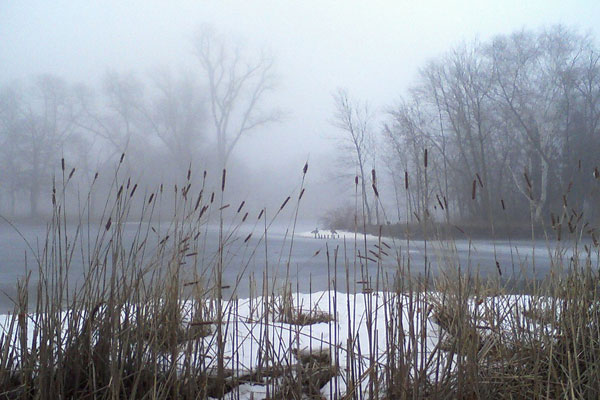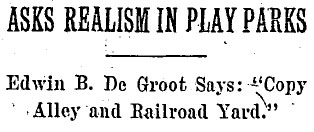
Humboldt Park
Finally got around to reading Blair Kamin's lengthy piece on Chicago's "park deserts":
Thirty-two of Chicago's 77 official community areas don't meet the city's 2-acres-per-1,000-people open-space standard, according to a new open-space inventory by city officials. The population of these areas is nearly 1.35 million people, half the city's total.
[snip]
Despite these gains, Chicago will rank 14th among 19 densely populated U.S. cities in parkland per 1,000 residents in a soon-to-be-released survey by The Trust for Public Land, a San Francisco-based advocacy group.
Roughly a quarter of Chicago's 12,000 acres of open space remains concentrated on the lakefront.
Readers responded; there's a wonderfully grouchy letter—back in my day, we didn't have "parks" or this "air conditioning" ("please accentuate the positive and stop griping")—but there's an interesting one from Carey Lundin, director of the forthcoming documentary Jens Jensen: Harmonious World, who brings up a man who could have done something about the lack of parks on the West Side and why we can't have anything nice:
The citys emerald belt found in Burnham's 1909 Plan of Chicago is in fact the work of Jen Jensen and architect Dwight Perkins from their 1903 Special Parks Commission Report. It is because of Jensen that today we have our Cook County Forest Preserves and many of our greatest state parks.
By 1917, Jensen also saw we were already running out of access to green space. His Plan for a Greater West Park System called for thousands of acres of parks, boulevards, greenways and community gardens. But due to a corrupt government, that bold plan was never realized.
What happened? In 1908, the Trib reported:
That subtle thing called the "artistic temperament" is blamed by John F. Smulski, president of the west park commission, for the differences between himself and Jens Jensen, superintendent of the parks.
[snip]
On the other hand, it is stated by friends of Mr. Jensen that policies may have played a part in the selection of certain laborers who hold minor jobs at the parks to the detriment of discipline and good service…. It is said also that Mr. Smulski has not agreed with Mr. Jensen's ideas concering shrubs and flowers and park beautification, preferring landscape gardening of the old school.
In a later piece:
Mr. Jensen is reported as being aggressively and militantly "nonpolitical," and it is recognized that there is a constant pressure on the park administration from politicians seeking patronage.
Jensen survived that push, but finally got booted out in 1921 from his position of landscape architect of the west-side parks because, his friends said, "a similar position will be created, with a different title, and that it will be filled by a Lundin-Thompson organization man.
Anyway, reading up on Jensen led me down a couple interesting paths. First, "The Man With the Plan," a wondefully contrarian piece by James Krohe arguing that Daniel Burnham wasn't all that. Among his arguments is the differing visions Burnham and Jensen had for the city, the consequences of which are reflected in Kamin's article:
While Burnham's Plan was the gaudiest and grandest of the plans being devised for Chicago, it was hardly the only one, and arguably not the best one. In 1920 Jens Jensen published an exhaustive study of the possibilities of expanding the system of parks of the West Park Commission, one of the forerunners of today's Chicago Park District. Unlike the geometrical array of Burnhamian boulevards, Jensen's pleasure drives would have hugged the topography of the west side's prehistoric beaches. Jensen called for a boating canal to connect the Chicago and Des Plaines rivers, and for municipal kitchen gardens where local residents might raise their own food and sell it. Jensen's plan thus would have extended to the city's working people the amenities and variety that the middle class were by then fleeing to the suburbs to find.
Jensen's criticisms of the 1909 Plan ring true today. As is explained by Robert Grese in his new book, Jens Jensen, Jensen complained in 1911 that housing, not the circulation of goods, ought to have been Burnham's point, arguing, "You cannot have a good and beautiful city with ideal conditions on its fringe and rotten conditions in its interior." Jensen offered a city oriented to neighborhoods rather than to a ceremonial lakefront, with factories and schools designed to that scale rather than to Burnham's regional scale.
Second, a plan for Chicago's parks that definitely didn't happen.

Edwin B. De Groot was the athletic director of the "south park commission," who presented his plan to "an audience of social workers at the City club" in a 1908 "symposium on Chicago's playgrounds," in which Jensen was in attendance (and complained about the city's inadequate west-side parks).
The alley, the dock, and the railroad yard are the models after which the "small park" and the municipal playgrounds of Chicago must be patterened if they are to be successful in attracting the average Chicago youngster. Social workers never will succeed in making their makeshifts quite as attractive as the original, but in a degree they can be copied and the sooner this is done the better it will be for the child.
[snip]
"Too much attention is paid to the little children at the playgrounds," said Mr. De Groot. "The games, the apparatus, and the manner of directing the parks are all adapted too closely to the younger ones, while the working boys and girls—the ones who most need what the small parks give—are neglected. We must have a change if we are to fulfill the function of these recreation centers.
"We can never succeed in making our playgrounds quite as attractive as the streets, the alleys, the docks, and the railroad yards. For the city urchin of the working age these seem to be the natural playgrounds."
I don't entirely agree with De Groot; if my reading habits as a little child are any indication, parks modeled on alleys, docks, and railroad yards would have been a wonder to me. Otherwise: co-sign. After the Bloomingdale Trail, a dry dock at the Children's Museum on Navy Pier should come next.
Third, "His Imagination Ran Wild," a piece about Jensen protege Alfred Caldwell, the man behind Promontory Point and "the last of the Prairie School architects."
Fourth, a memory of Jensen from his great-grandson: "You get a taste of Jens Jensen’s determination and persuasive powers in his book Siftings, where he wrote: 'It is often remarked native plants are coarse. How humiliating to hear an American speak so of plants with which the Great Master has decorated his land!'"
Photograph: ky_olsen (CC by 2.0)


